-2024届高三英语二轮复习it 的用法总结归纳课件(共28张PPT)
文档属性
| 名称 | -2024届高三英语二轮复习it 的用法总结归纳课件(共28张PPT) | 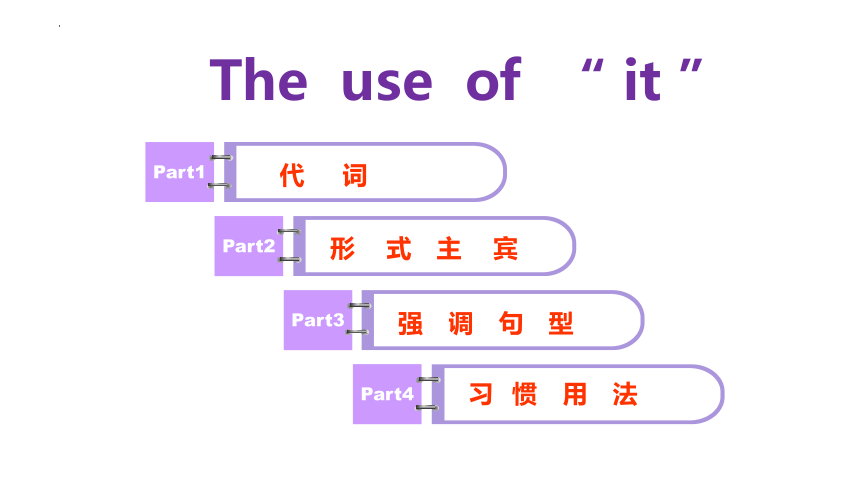 | |
| 格式 | pptx | ||
| 文件大小 | 1.8MB | ||
| 资源类型 | 教案 | ||
| 版本资源 | 通用版 | ||
| 科目 | 英语 | ||
| 更新时间 | 2023-12-12 12:49:11 | ||
图片预览



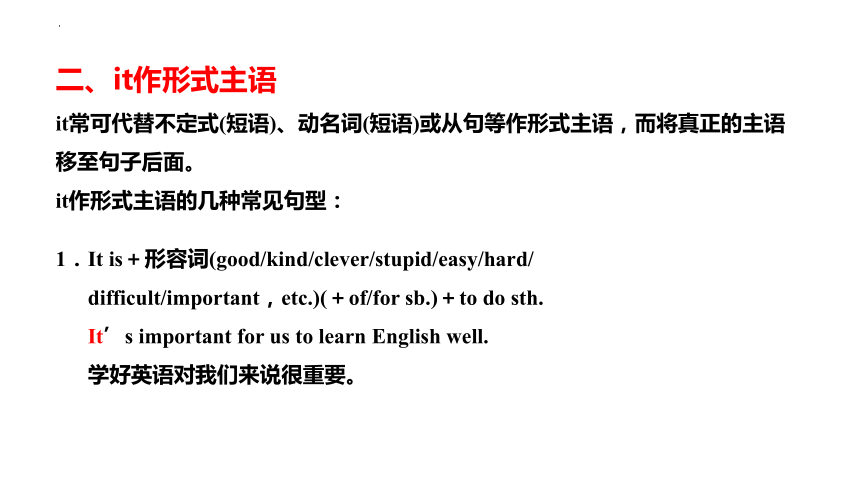
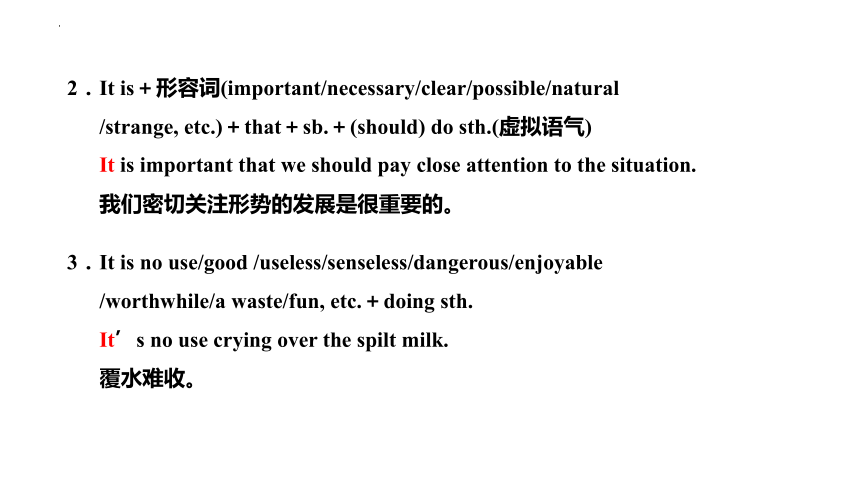
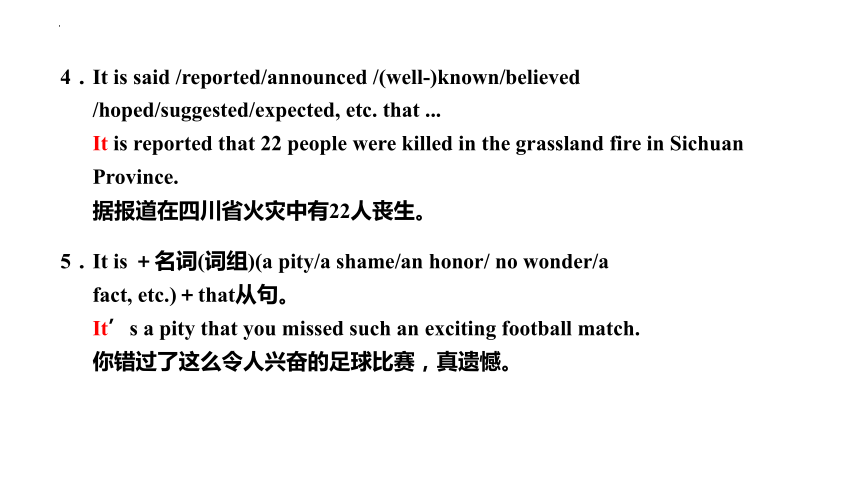
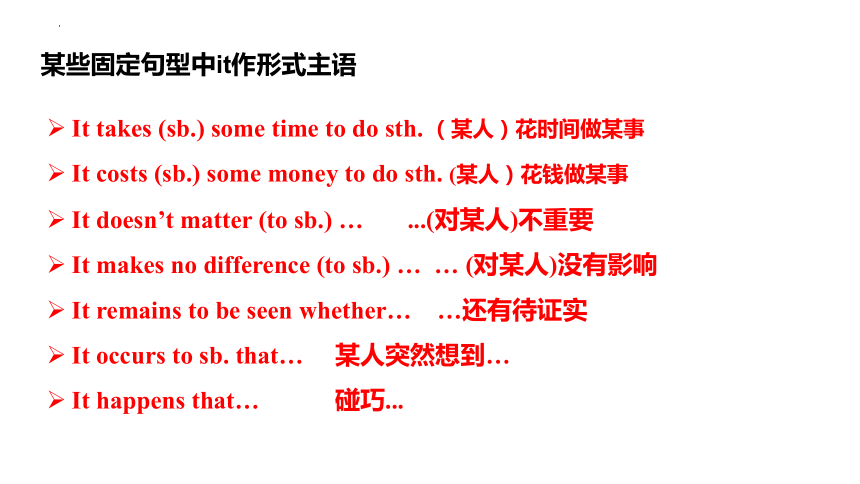
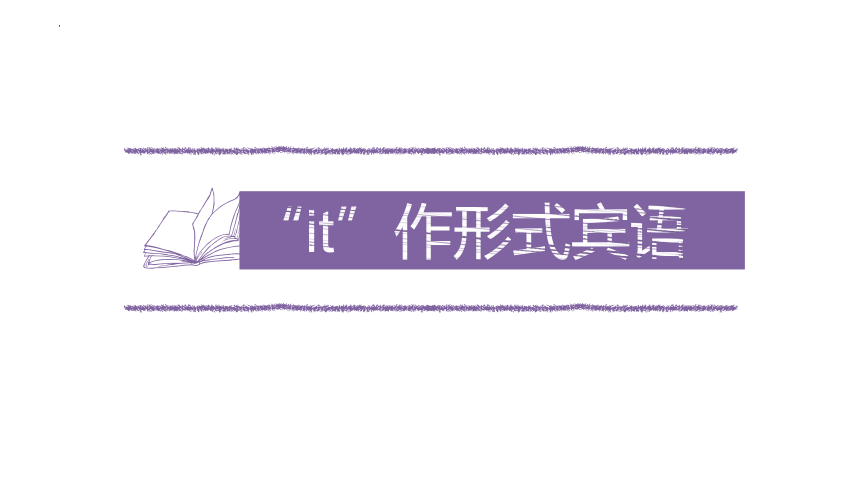
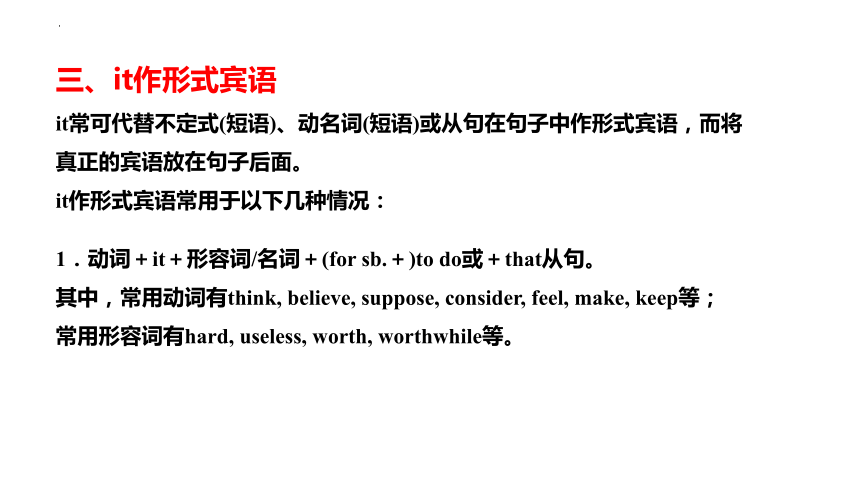
文档简介
(共28张PPT)
Part1
代 词
Part2
形 式 主 宾
Part3
强 调 句 型
Part4
习 惯 用 法
The use of “ it ”
“it”作形式主语
To remember this rule is important.
2. Chatting on the Internet is a waste of time.
3. Whether you come or not doesn’t interest me.
It is important to remember this rule.
It is a waste of time chatting on the Internet.
It doesn’t interest me whether you come or not.
用it改写下列句子:
小结:当不定式、动名词、从句等用作句子主语时,为保持句子平衡,通常把真正的主语放在句末,而在句首使用形式主语it.
二、it作形式主语
it常可代替不定式(短语)、动名词(短语)或从句等作形式主语,而将真正的主语移至句子后面。
it作形式主语的几种常见句型:
1.It is+形容词(good/kind/clever/stupid/easy/hard/
difficult/important,etc.)(+of/for sb.)+to do sth.
It’s important for us to learn English well.
学好英语对我们来说很重要。
2.It is+形容词(important/necessary/clear/possible/natural
/strange, etc.)+that+sb.+(should) do sth.(虚拟语气)
It is important that we should pay close attention to the situation.
我们密切关注形势的发展是很重要的。
3.It is no use/good /useless/senseless/dangerous/enjoyable
/worthwhile/a waste/fun, etc.+doing sth.
It’s no use crying over the spilt milk.
覆水难收。
4.It is said /reported/announced /(well )known/believed
/hoped/suggested/expected, etc. that ...
It is reported that 22 people were killed in the grassland fire in Sichuan Province.
据报道在四川省火灾中有22人丧生。
5.It is +名词(词组)(a pity/a shame/an honor/ no wonder/a
fact, etc.)+that从句。
It’s a pity that you missed such an exciting football match.
你错过了这么令人兴奋的足球比赛,真遗憾。
It takes (sb.) some time to do sth. (某人)花时间做某事
It costs (sb.) some money to do sth. (某人)花钱做某事
It doesn’t matter (to sb.) … ...(对某人)不重要
It makes no difference (to sb.) … … (对某人)没有影响
It remains to be seen whether… …还有待证实
It occurs to sb. that… 某人突然想到…
It happens that… 碰巧...
某些固定句型中it作形式主语
“it”作形式宾语
三、it作形式宾语
it常可代替不定式(短语)、动名词(短语)或从句在句子中作形式宾语,而将真正的宾语放在句子后面。
it作形式宾语常用于以下几种情况:
1.动词+it+形容词/名词+(for sb.+)to do或+that从句。
其中,常用动词有think, believe, suppose, consider, feel, make, keep等;
常用形容词有hard, useless, worth, worthwhile等。
I think it important that you (should) attend the conference.
我认为你参加这次会议很重要。
I found it hard to get on with Mary.
我发现同玛丽相处很难。
2.动词+it+to sb.+that ...
常用句型有:
owe it to sb. that ... 把……归功于……
leave it to sb. that ... 把……留给某人去做
take it for granted that ... 认为……理所当然
keep it in mind that ... 把……记在心里
We owe it to you that we finished the work on time.
多亏了你我们才按时完成了这项工作。
I leave it to your own judgment whether you should do it.
我让你自己判断这事是否该做。
3.动词(短语)+it+that/when/if ...
常用在此结构中的动词(短语)有:
enjoy, like, love, dislike, appreciate, hate, prefer, see to, depend on, insist on等。
See to it that the goods are kept well.
注意这些货物要保存好。
I like it when the weather is fine in autumn.
我喜欢秋高气爽的天气。
“it”作人称代词
1. It gets dark very early in the winter.
2. What will you call it if it’s a boy
3. I love spring---It’s a wonderful time of the year.
4. It’s less than 100 kilometres from here to Jinan.
5. When the factory closes, it will mean 500 people
losing their jobs.
6. The little animal is a monkey and it lives in Sichuan.
7. It has snowed much this year.
指时间
指婴儿(性别不明)
指季节
指距离
指上文提到的事
指天气
指上文提到的动物
What does “it” refer to
一、it用作代词
1.it用作人称代词,代替前文提到的事物、性别不明的人或动物,未指明但谈话双方都明白的事情或情况。
— Who is knocking at the door
—It’ s me.
We bought a new house but it will need a lot of work before we can move in.
(性别不明)
(代替前文提到的事物)
2.用来代替指示代词this, that 或不定代词something, nothing等。
— Is this your new computer
— No, it isn’t.
— What’s that
— It’s Tom’s passport.
Whenever she sees something that she likes, she goes and buys it.
3.it作非人称代词,常用于指代时间、距离、自然现象、环境、情况等。
It’s time to get up.
It’s going to snow.
It is a long way from my school to the hospital.
It was very quiet in the café.
----What's the cost of the T-shirt
----It is 150 yuan.
(指时间)
(指天气)
(指距离)
(指环境)
(指价值)
it 指代上文提到的表特指的单数可数名词或不可数名词,即“同类又同物”;
one表示“同类泛指”, 只能代替可数名词单数,相当于a/an+可数名词单数。
ones : 同类泛指,替代前面出现的可数名词复数
that 表示“同类不同物”,替代前文出现的表特指的可数名词单数或不可数名词。
I had a good pen, but I lost it yesterday. I’ll buy one tomorrow.
There are many books in this shop. Would you recommend some good ones
The weather here is better than that in Shanghai.
注 : it, one, ones, that 区别
“it”用于强调句型
I
Mary
in the street
yesterday
It was I that/who met Mary in the street yesterday.
It was Mary that I met in the street yesterday.
It was in the street that I met Mary yesterday.
It was yesterday that I met Mary in the street.
结构:
It be + 被强调部分 +that /who +句子其他成分
I met Mary in the street yesterday.
1. It 无意义,不可换成this/that. 2. be 只用单数 is/was
3.被强调的部分不能为谓语动词. 4. 强调的部分是人 也可用who其它一律用that.
强调主语时,that后动词的人称和数的变化要与前面被强调的名词或代词一致。
高考考点
1. 与主谓一致结合一起考查
被强调部分如果是主语,who/that之后的谓语动词在人称和数上
应与主语保持一致。
It is he who _____ wrong.
2. 强调句型与定语从句、主语从句、宾语从句、状语从句结合在一起
It was at the school ___________ was named after the hero ______ he spent his childhood.
Do you know _____it was that came up with the bright idea?
is
that /which
that
who
I didn’t realize she was a famous film star until she took off her dark glasses.
= Not until she took off her dark glasses did I realize she was a famous film star.
=It was not until she took off her dark glasses that I realized she was a famous film star.
It is not until + 被强调部分 + that ...
该句型也是强调句型。主要用于强凋时间状语,译成汉语 “直到……才……”,可以说是not ... until ... 的强调形式。
代词 it 本意它, 既可指这又指那;
时间天气均可指, 谈到距离也用它;
假主假宾均可作, 强调句型跟that。
It 用法口诀:
“it”固定用法
①.It is time ( high time ) for sb. to do sth./that ...
It is time for us to leave.
=It’s time that we left.
=it is time that we should leave.
②. It is/was the first ( second ... ) time that have /had done...
It is the first time that I have been praised.
It was the second time that I had visited the Great Wall.
③. It is / was ... when ... (当…的时候时间是…)
It was midnight when we got home.
固定用法
当主句谓语动词是is时,从句用现在完成时;当主句谓语动词是was时,从句用过去完成时
④. It + be + 一段时间 + since… (自从…以来有一段时间了)
It is three years since he graduated.
自从他毕业以来,已经三年了。
It is two years since he workd here.
自从他不在那儿工作以来,已经两年了。
⑤. It +be +时间段 + before ...(在…之前有一段时间)
It will be two years before we meet again.
It was some time before I realized the truth.
短暂性动词从动作开始的时候算起,
延续性动词从动作结束的时候算起。
六、It 常用的固定搭配
1. make it
a. 在口语当中相当于succeed,表示:成功、做到、说定、赶上、及时到达。
It's hard to make it to the top in show business.
b. 在口语中相当于fix the date for,表示“约定好时间”。
—Shall we meet next week?
—OK. We just make it next Saturday.
2. take it/things easy
相当于Don’t worry or don’t hurry.
用来劝告别人,表示“不要慌,别担心,沉住气”。
Take it easy! He will do it well.
3. It all depends/that all depends
在口语中,相当于it hasn’t been decided yet,表示那得看情况,还没有定下来。
—Are you going to the countryside for holiday?
—It/That all depends.
4. It's up to sb.
在口语中,相当于it's decided by sb. 表示“由…决定,由…负责,取决于…”
—Shall we go out for dinner?
—It's up to you.
Part1
代 词
Part2
形 式 主 宾
Part3
强 调 句 型
Part4
习 惯 用 法
The use of “ it ”
“it”作形式主语
To remember this rule is important.
2. Chatting on the Internet is a waste of time.
3. Whether you come or not doesn’t interest me.
It is important to remember this rule.
It is a waste of time chatting on the Internet.
It doesn’t interest me whether you come or not.
用it改写下列句子:
小结:当不定式、动名词、从句等用作句子主语时,为保持句子平衡,通常把真正的主语放在句末,而在句首使用形式主语it.
二、it作形式主语
it常可代替不定式(短语)、动名词(短语)或从句等作形式主语,而将真正的主语移至句子后面。
it作形式主语的几种常见句型:
1.It is+形容词(good/kind/clever/stupid/easy/hard/
difficult/important,etc.)(+of/for sb.)+to do sth.
It’s important for us to learn English well.
学好英语对我们来说很重要。
2.It is+形容词(important/necessary/clear/possible/natural
/strange, etc.)+that+sb.+(should) do sth.(虚拟语气)
It is important that we should pay close attention to the situation.
我们密切关注形势的发展是很重要的。
3.It is no use/good /useless/senseless/dangerous/enjoyable
/worthwhile/a waste/fun, etc.+doing sth.
It’s no use crying over the spilt milk.
覆水难收。
4.It is said /reported/announced /(well )known/believed
/hoped/suggested/expected, etc. that ...
It is reported that 22 people were killed in the grassland fire in Sichuan Province.
据报道在四川省火灾中有22人丧生。
5.It is +名词(词组)(a pity/a shame/an honor/ no wonder/a
fact, etc.)+that从句。
It’s a pity that you missed such an exciting football match.
你错过了这么令人兴奋的足球比赛,真遗憾。
It takes (sb.) some time to do sth. (某人)花时间做某事
It costs (sb.) some money to do sth. (某人)花钱做某事
It doesn’t matter (to sb.) … ...(对某人)不重要
It makes no difference (to sb.) … … (对某人)没有影响
It remains to be seen whether… …还有待证实
It occurs to sb. that… 某人突然想到…
It happens that… 碰巧...
某些固定句型中it作形式主语
“it”作形式宾语
三、it作形式宾语
it常可代替不定式(短语)、动名词(短语)或从句在句子中作形式宾语,而将真正的宾语放在句子后面。
it作形式宾语常用于以下几种情况:
1.动词+it+形容词/名词+(for sb.+)to do或+that从句。
其中,常用动词有think, believe, suppose, consider, feel, make, keep等;
常用形容词有hard, useless, worth, worthwhile等。
I think it important that you (should) attend the conference.
我认为你参加这次会议很重要。
I found it hard to get on with Mary.
我发现同玛丽相处很难。
2.动词+it+to sb.+that ...
常用句型有:
owe it to sb. that ... 把……归功于……
leave it to sb. that ... 把……留给某人去做
take it for granted that ... 认为……理所当然
keep it in mind that ... 把……记在心里
We owe it to you that we finished the work on time.
多亏了你我们才按时完成了这项工作。
I leave it to your own judgment whether you should do it.
我让你自己判断这事是否该做。
3.动词(短语)+it+that/when/if ...
常用在此结构中的动词(短语)有:
enjoy, like, love, dislike, appreciate, hate, prefer, see to, depend on, insist on等。
See to it that the goods are kept well.
注意这些货物要保存好。
I like it when the weather is fine in autumn.
我喜欢秋高气爽的天气。
“it”作人称代词
1. It gets dark very early in the winter.
2. What will you call it if it’s a boy
3. I love spring---It’s a wonderful time of the year.
4. It’s less than 100 kilometres from here to Jinan.
5. When the factory closes, it will mean 500 people
losing their jobs.
6. The little animal is a monkey and it lives in Sichuan.
7. It has snowed much this year.
指时间
指婴儿(性别不明)
指季节
指距离
指上文提到的事
指天气
指上文提到的动物
What does “it” refer to
一、it用作代词
1.it用作人称代词,代替前文提到的事物、性别不明的人或动物,未指明但谈话双方都明白的事情或情况。
— Who is knocking at the door
—It’ s me.
We bought a new house but it will need a lot of work before we can move in.
(性别不明)
(代替前文提到的事物)
2.用来代替指示代词this, that 或不定代词something, nothing等。
— Is this your new computer
— No, it isn’t.
— What’s that
— It’s Tom’s passport.
Whenever she sees something that she likes, she goes and buys it.
3.it作非人称代词,常用于指代时间、距离、自然现象、环境、情况等。
It’s time to get up.
It’s going to snow.
It is a long way from my school to the hospital.
It was very quiet in the café.
----What's the cost of the T-shirt
----It is 150 yuan.
(指时间)
(指天气)
(指距离)
(指环境)
(指价值)
it 指代上文提到的表特指的单数可数名词或不可数名词,即“同类又同物”;
one表示“同类泛指”, 只能代替可数名词单数,相当于a/an+可数名词单数。
ones : 同类泛指,替代前面出现的可数名词复数
that 表示“同类不同物”,替代前文出现的表特指的可数名词单数或不可数名词。
I had a good pen, but I lost it yesterday. I’ll buy one tomorrow.
There are many books in this shop. Would you recommend some good ones
The weather here is better than that in Shanghai.
注 : it, one, ones, that 区别
“it”用于强调句型
I
Mary
in the street
yesterday
It was I that/who met Mary in the street yesterday.
It was Mary that I met in the street yesterday.
It was in the street that I met Mary yesterday.
It was yesterday that I met Mary in the street.
结构:
It be + 被强调部分 +that /who +句子其他成分
I met Mary in the street yesterday.
1. It 无意义,不可换成this/that. 2. be 只用单数 is/was
3.被强调的部分不能为谓语动词. 4. 强调的部分是人 也可用who其它一律用that.
强调主语时,that后动词的人称和数的变化要与前面被强调的名词或代词一致。
高考考点
1. 与主谓一致结合一起考查
被强调部分如果是主语,who/that之后的谓语动词在人称和数上
应与主语保持一致。
It is he who _____ wrong.
2. 强调句型与定语从句、主语从句、宾语从句、状语从句结合在一起
It was at the school ___________ was named after the hero ______ he spent his childhood.
Do you know _____it was that came up with the bright idea?
is
that /which
that
who
I didn’t realize she was a famous film star until she took off her dark glasses.
= Not until she took off her dark glasses did I realize she was a famous film star.
=It was not until she took off her dark glasses that I realized she was a famous film star.
It is not until + 被强调部分 + that ...
该句型也是强调句型。主要用于强凋时间状语,译成汉语 “直到……才……”,可以说是not ... until ... 的强调形式。
代词 it 本意它, 既可指这又指那;
时间天气均可指, 谈到距离也用它;
假主假宾均可作, 强调句型跟that。
It 用法口诀:
“it”固定用法
①.It is time ( high time ) for sb. to do sth./that ...
It is time for us to leave.
=It’s time that we left.
=it is time that we should leave.
②. It is/was the first ( second ... ) time that have /had done...
It is the first time that I have been praised.
It was the second time that I had visited the Great Wall.
③. It is / was ... when ... (当…的时候时间是…)
It was midnight when we got home.
固定用法
当主句谓语动词是is时,从句用现在完成时;当主句谓语动词是was时,从句用过去完成时
④. It + be + 一段时间 + since… (自从…以来有一段时间了)
It is three years since he graduated.
自从他毕业以来,已经三年了。
It is two years since he workd here.
自从他不在那儿工作以来,已经两年了。
⑤. It +be +时间段 + before ...(在…之前有一段时间)
It will be two years before we meet again.
It was some time before I realized the truth.
短暂性动词从动作开始的时候算起,
延续性动词从动作结束的时候算起。
六、It 常用的固定搭配
1. make it
a. 在口语当中相当于succeed,表示:成功、做到、说定、赶上、及时到达。
It's hard to make it to the top in show business.
b. 在口语中相当于fix the date for,表示“约定好时间”。
—Shall we meet next week?
—OK. We just make it next Saturday.
2. take it/things easy
相当于Don’t worry or don’t hurry.
用来劝告别人,表示“不要慌,别担心,沉住气”。
Take it easy! He will do it well.
3. It all depends/that all depends
在口语中,相当于it hasn’t been decided yet,表示那得看情况,还没有定下来。
—Are you going to the countryside for holiday?
—It/That all depends.
4. It's up to sb.
在口语中,相当于it's decided by sb. 表示“由…决定,由…负责,取决于…”
—Shall we go out for dinner?
—It's up to you.
